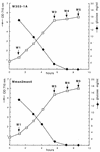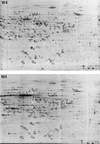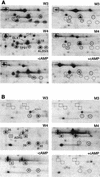Msn2p and Msn4p control a large number of genes induced at the diauxic transition which are repressed by cyclic AMP in Saccharomyces cerevisiae
- PMID: 9495741
- PMCID: PMC106990
- DOI: 10.1128/JB.180.5.1044-1052.1998
Msn2p and Msn4p control a large number of genes induced at the diauxic transition which are repressed by cyclic AMP in Saccharomyces cerevisiae
Abstract
The multicopy suppressors of the snf1 defect, Msn2p and Msn4p transcription factors (Msn2/4p), activate genes through the stress-responsive cis element (CCCCT) in response to various stresses. This cis element is also the target for repression by the cyclic AMP (cAMP)-signaling pathway. We analyzed the two-dimensional gel electrophoresis pattern of protein synthesis of the msn2 msn4 double mutant and compared it with that of the wild-type strain during exponential growth phase and at the diauxic transition. Thirty-nine gene products (including those of ALD3, GDH3, GLK1, GPP2, HSP104, HXK1, PGM2, SOD2, SSA3, SSA4, TKL2, TPS1, and YBR149W) are dependent upon Msn2/4p for their induction at the diauxic transition. The expression of all these genes is repressed by cAMP. Thirty other genes identified during this study are still inducible in the mutant. A subset of these genes were found to be superinduced at the diauxic transition, and others were subject to cAMP repression (including ACH1, ADH2, ALD6, ATP2, GPD1, ICL1, and KGD2). We conclude from this analysis that Msn2/4p control a large number of genes induced at the diauxic transition but that other, as-yet-uncharacterized regulators, also contribute to this response. In addition, we show here that cAMP repression applies to both Msn2/4p-dependent and -independent control of gene expression at the diauxic shift. Furthermore, the fact that all the Msn2/4p gene targets are subject to cAMP repression suggests that these regulators could be targets for the cAMP-signaling pathway.
Figures






References
-
- Bataillé N, Régnacq M, Boucherie H. Induction of a heat-shock-type response in Saccharomyces cerevisiae following glucose limitation. Yeast. 1991;7:367–378. - PubMed
-
- Boucherie H, Dujardin G, Kermogant M, Monribot C, Slonimsky P, Perrot M. Two dimensional protein map of Saccharomyces cerevisiae: construction of a gene-protein index. Yeast. 1995;11:601–613. - PubMed
-
- Boucherie H, Sagliocco F, Joubert R, Maillet I, Labarre J, Perrot M. Two-dimensional gel protein data of Saccharomyces cerevisiae. Electrophoresis. 1996;17:1683–1699. - PubMed
Publication types
MeSH terms
Substances
LinkOut - more resources
Full Text Sources
Other Literature Sources
Molecular Biology Databases
Miscellaneous

